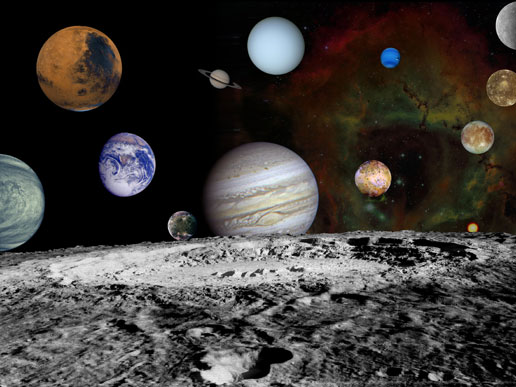Planets in our Solar SystemA WebQuestIntroduction | Task | Process | Evaluation | Conclusion | Credits |
 |
You and your partner have been asked by NASA to visit and explore one of the planets in our solar system. There are eight planets: Mercury, Venus, Earth, Mars, Jupiter, Saturn, Uranus, and Neptune. Also, there is Pluto, it is a dwarf planet. All of these planets are fascinating and worthy of exploration. NASA only has funds to explore just one planet so your group must pick the best one and convince NASA that it is the one most worthy to explore.
You and your partner will begin by learning about all the planets and comparing them using the "Planets Comparison Table"
- what the surface is like
- it’s size (diameter) of the planet
- it’s atmosphere
- it’s climate (temperature range)
- it’s distance from the sun
- whether it is an inner or outer planet
- if it has satellites (moons) how many it has
- the length of a day (how long it takes to rotate on its axis)
- the length of year (how long it takes to orbit around the sun)
- whether or not it has been visited by spacecraft
- whether or not it is likely to have life on it
- most fascinating facts about the planet
Then you should take the "Solar System Quiz"
Then you should create a 2 minute PhotoStory presentation to share the data and explain why NASA should fund the exploration of your planet.
Before you decide which planet to select please visit the website, http://kids.nineplanets.org/ to get basic understanding of each planet. Decide as a group which planet you will create your PhotoStory on. Next find and record the answers to the following questions using at least two of the websites below:
- http://www.nasa.gov/worldbook/planet_worldbook_update.html
- http://kids.nineplanets.org/
- http://www.nineplanets.org/
- http://solarsystem.jpl.nasa.gov/planets/index.cfm
- http://www.enchantedlearning.com/subjects/astronomy/planets/index.shtml
Record where you found your information:
Article: ______________________________________________________
Title of website________________________________________________
URL of site___________________________________________________
Date viewed__________________________________________________
For example:
Article: Mercury
Title of website: The Nine Planets for Kids
URL: http://kids.nineplanets.org/
Date viewed: June 14, 2010
Presentation Rubric |
||||
Scale |
1 |
2 |
3 |
4 |
Students identified the most/least planets in the Planet Comparison Table |
Students correctly identified less than 50% |
Students correctly identified 51-79% correctly. |
Students identified 80-89% correctly. |
Students identified 90-100% correctly.. |
Students produce a product that is attractive and creative. |
Use of font, color, graphics, effects, etc. is evident, but these often distract from the presentation of content. |
Makes use of font, color, graphics, effects, etc., but occasionally there detract from the presentation of content. |
Makes good use font, color, graphics, effects etc. to enhance the presentation. |
Makes excellent use of font, color, graphics, effects, etc. to enhance the presentation. |
Students produce a product that is organized |
There was no clear of logical organizational structure. |
Most of the content is logically organized and clearly presented. |
The overall organization and presentation is appropriate. |
Content is well organized, easy to understand, and clearly presented. |
Students include all the required facts |
0-4 facts are included. Or more facts are included by are mostly incorrect |
5-7 facts are included accurately. Others may be included by are inaccurate. |
8-11 facts are included accurately. Others may be included by are inaccurate. |
12 or more are included and are accurate. |
Students produce a product that exhibits proper mechanics. |
More than 4 errors are spelling or grammar. |
Four misspellings and/or grammatical errors. |
No misspellings or grammatical errors and the language is appropriate. |
No misspellings or grammatical errors and the language used shows an in depth understanding of the material. |
Students cite their accurately |
Students fail to cite their sources |
Students cite some of their sources. But, they are not cited accurately. |
Students cite most of their sources, mostly accurately. |
Students cite all their sources accurately. |
Students make a persuasive argument |
Presentation receives no votes. |
Presentation receives less than 25% of class support. |
Presentation receives more than 25% of class support. |
Presentation receives over 90% vote of support. |
Create your PhotoStory about your planet covering the facts you identified and why NASA should fund exploration of your planet. Carefully read the evaluation rubric so you will know how your project will be evaluated. In addition to your teacher’s evaluation the number of votes your PhotoStory receives from your classmates will be used to determine how convincing you are that your planet is the most interesting and therefore worthy of NASA funding its exploration.
Images Courtesy of NASA
